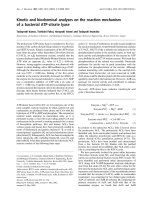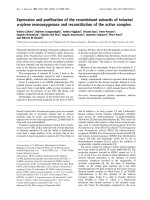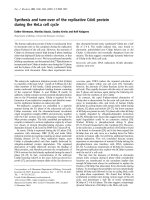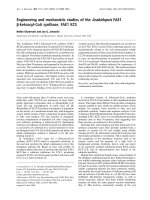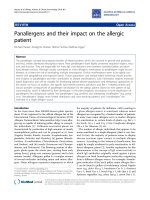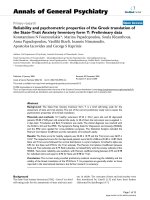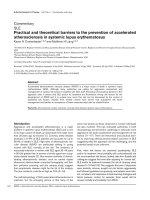Báo cáo y học: "Foot and ankle injuries during the Athens 2004 Olympic Games." pdf
Bạn đang xem bản rút gọn của tài liệu. Xem và tải ngay bản đầy đủ của tài liệu tại đây (235.47 KB, 8 trang )
BioMed Central
Page 1 of 8
(page number not for citation purposes)
Journal of Foot and Ankle Research
Open Access
Research
Foot and ankle injuries during the Athens 2004 Olympic Games
Thanos Badekas*, Stamatios A Papadakis
†
, Nikolaos Vergados
†
,
Spyros P Galanakos
†
, Angeliki Siapkara
†
, Mike Forgrave
†
, Nick Romansky
†
,
Steven Mirones
†
, Hans-Jeorg Trnka
†
and Marino Delmi
†
Address: Olympic Village Polyclinic, Foot and Ankle Department, Health Services Athens 2004 Olympic Games, Athens, Greece
Email: Thanos Badekas* - ; Stamatios A Papadakis - ;
Nikolaos Vergados - ; Spyros P Galanakos - ;
Angeliki Siapkara - ; Mike Forgrave - ; Nick Romansky - ;
Steven Mirones - ; Hans-Jeorg Trnka - ; Marino Delmi -
* Corresponding author †Equal contributors
Abstract
Background: Major, rare and complex incidents can occur at any mass-gathering sporting event
and team medical staff should be appropriately prepared for these. One such event, the Athens
Olympic Games in 2004, presented a significant sporting and medical challenge. This study concerns
an epidemiological analysis of foot and ankle injuries during the Games.
Methods: An observational, epidemiological survey was used to analyse injuries in all sport
tournaments (men's and women's) over the period of the Games.
Results: A total of 624 injuries (525 soft tissue injuries and 99 bony injuries) were reported. The
most frequent diagnoses were contusions, sprains, fractures, dislocations and lacerations.
Significantly more injuries in male (58%) versus female athletes (42%) were recorded. The
incidence, diagnosis and cause of injuries differed substantially between the team sports.
Conclusion: Our experience from the Athens Olympic Games will inform the development of
public health surveillance systems for future Olympic Games, as well as other similar mass events.
Background
The Olympic Games represent the ultimate challenge for
competitors. However, they are associated with a certain
risk of injury for the participating players or athletes.
Appropriate planning and staffing for medical services at
large-scale athletic events is essential to provide for a safe
and successful contest. Increased public health surveil-
lance was first described for the 1984 summer Olympic
Games in Los Angeles [1].
The XXVIII Olympic Games competition period held in
Athens commenced on August 11, the Games declared
open on August 13, and the period of competition that
hosted 28 sports (swimming, diving, synchronised swim-
ming and water polo are classified by the IOC as disci-
plines within the sport of aquatics, and wheelchair racing
was a demonstration sport) concluded with the Closing
Ceremony on August 29 2004. Eleven thousand and
ninety-nine athletes competed, some 600 more than
Published: 12 April 2009
Journal of Foot and Ankle Research 2009, 2:9 doi:10.1186/1757-1146-2-9
Received: 18 August 2008
Accepted: 12 April 2009
This article is available from: />© 2009 Badekas et al; licensee BioMed Central Ltd.
This is an Open Access article distributed under the terms of the Creative Commons Attribution License ( />),
which permits unrestricted use, distribution, and reproduction in any medium, provided the original work is properly cited.
Journal of Foot and Ankle Research 2009, 2:9 />Page 2 of 8
(page number not for citation purposes)
expected, accompanied by 5,501 team officials from 202
countries.
There were 301 medal events in 28 different sports. The
Athens Organising Committee (AOC) was responsible for
planning and delivery of both the Olympic and Paralym-
pic Games. The AOC Medical Commission principles of
protecting the health of athletes, respect of both medical
and sport ethics, and equality for all competing athletes
were a high priority for the establishment of the medical
facilities for Athens 2004.
The Foot and Ankle Department was responsible for all
lower limb, foot and ankle injuries encompassing bone,
muscle, tendon, other soft tissue structures and skin con-
ditions. An array of acute and chronic musculoskeletal
conditions were investigated, diagnosed and treated,
encompassing bone stress, tendonopathies, fasciitis and
muscle dysfunction, biomechanical overload, the investi-
gation of overload injuries and rectification of footwear
issues.
The Foot and Ankle Department was not only present at
the Polyclinic but also attended competition and training
venues involving track and field, marathon, race walks,
volleyball and basketball. In addition, access to other ven-
ues for sports that required lower limb injury surveillance
and treatment, such as tennis, enabled the medical service
to provide a comprehensive and cohesive multidiscipli-
nary sports medicine approach. At these venues the Foot
and Ankle Department worked with other members of the
medical team to provide pre-event, intra-event and imme-
diate post-event care for all athletes. When necessary more
extensive investigation and treatment was referred to the
Polyclinic.
The purpose of this study was to report foot and ankle
injuries at the 2004 Athens Olympic Games and to assist
in the planning of similar events in the future.
Methods
Medical Organisation
The medical organisational structure was directed by 5
managers: a Medical Manager for the Competition Ven-
ues, a Medical Manager for the Non-Competition Venues,
a local Medical Director for the Polyclinic, a Complex
Venue Medical Manager, and a Liaison Manager (for the
Hospitals, Emergency Medical System (EMS), Public
Health, Supplies, and Staffing). The health services per-
sonnel consisted of 5,210 individuals. Of those, 1120
were Health Care Providers (including 360 Medical Doc-
tors (MD), 480 Nurses, 180 Massage Therapists, 40 Den-
tists, 30 Opticians and 30 Podiatrists), 760 were
employees of hospitals (first aid, EMS), 120 were respon-
sible for public health/hygiene, and the 200 others were
administrative personnel. The role of 3,010 volunteers
was also noteworthy.
The Polyclinic in the Olympic Village was a very impor-
tant structural part of the medical organisation. The Poly-
clinic had an emergency ward (which was supported by
ambulance services), outpatient services (Internal Medi-
cine, Orthopaedics, Foot and Ankle, Ear-Nose-Throat,
Dermatology, Gynaecology, Cardiology and Psychiatry),
short-term observation room, Dentistry, Physical Ther-
apy-Rehabilitation, Imaging Department, Laboratory and
Pharmacy. Although the polyclinic was available to all
athletes, teams from some countries had their own physi-
cians and other medical personnel. These medical teams
were provided separate space within their residential
areas. In addition, there were Health Care Interpreters
employed by the Polyclinic, medical staff for doping con-
trol and IOC Medical Commission staff for medication
notification.
Structure and functioning of the Foot and Ankle
Department
The delivery of foot and ankle care for Athens 2004 com-
menced in August 2001. Over a period of three years the
framework for foot and ankle surgeons' roles was estab-
lished inclusive of; overseeing infrastructure building
requirements, planning of athlete care, sourcing inventory
such as medical equipment and consumables, develop-
ment of administration procedures, selection of a team,
rostering of work shifts, billeting of interstate orthopaedic
surgeons, liaison with other medical disciplines to coordi-
nate the most effective approach to athlete care, and liai-
son with medical teams from National Olympic
Committees (NOCs) and National Paralympic Commit-
tees (NPCs).
The Foot and Ankle Department operated from the 31
st
of
July until the 30
th
of August 2004 and it employed 36
staff; 5 of which were Orthopedic Surgeons specialised in
Foot and Ankle Surgery, 15 were Podiatrists and 15 Certi-
fied Pedorthists (CPeds). The department included a
reception area, two examination rooms, one pedo-
barograph machine and a laboratory for the construction
of insoles and orthoses. It was open from 8 am to 10 pm
and the operation was divided into two shifts. In each
shift there was at least one MD with two Doctors of Podi-
atric Medicine and two to three CPeds. Interview rooms
were also available for consultation with practitioner, ath-
lete, radiologist and coach or medical officer of the patient
when images were interpreted. A centralised sterilisation
area was located within the Polyclinic that served all
departments.
Journal of Foot and Ankle Research 2009, 2:9 />Page 3 of 8
(page number not for citation purposes)
Data collection
An observational, epidemiological survey was used to
analyse injuries in all sport tournaments (men's and
women's) over the period of the Games. To achieve this
we retrospectively analysed the medical records of 624
patients that were consulted by the Foot and Ankle
Department. For all types of injuries, the following infor-
mation were documented: sex, age, injured body part and
type of injury, circumstances (noncontact, contact, foul
play), and consequences of injury (referee's sanction,
treatment, time-loss in sport). Because follow-up was not
possible, the physicians were asked to state an estimate of
the duration of the player's likely absence from training
and/or matches as a result of the injury. All team sports, as
well as the athletes which were included in this report, fol-
lowed the same methodology. Information was collected
from the logbooks and medical encounter forms. Data
collection started when the Olympic Village was open and
lasted until the end of the Olympic Games.
Results
During the Olympic period August 1
st
to September 1
st
,
624 patients presented to the Foot and Ankle Department
for treatment. The mean age of athletes was 24 years
(range 21 to 32), whereas the mean age of the media,
Olympic family and officials was older at 42 years (range
28 to 57). Among the patients there were more males, 358
(58%) than females, 266 (42%). A detailed breakdown of
the injuries sustained is included in Table 1. Athlete med-
ical encounters represented 64% of the patients, person-
nel 18%, coach 7%, IOC family 6%, and 5% were
classified as other. 84.1% of consultations were cases
relating to musculoskeletal injury. The rest (15.9%)
related to primary care issues, which involved the treat-
ment of skin and nail conditions, and diabetic care. Figure
1 shows the frequency of consultations on each day of
operation of the Foot and Ankle Department.
In 80% of consultations, acute management was carried
out encompassing conditions such as onychocryptosis,
paronychia and petechiae blisters. 218 acute injuries were
treated (117 during event and 101 out of event), whereas
201 were old injuries and 25 were acute trauma on
chronic preexisting problems. Essential to podiatric man-
agement was the availability of imaging facilities inclusive
of plain films, magnetic resonance imaging, computerised
tomography, diagnostic ultrasound and podobarograph
(Figure 2).
Musculoskeletal injury (84.1%) included acute injury,
overuse injury and injury due to biomechanical anoma-
lies. The consultations encompassing acute injury were
diverse and involved an array of conditions including:
ankle sprains; foot, tibial and fibula fractures; tendon
tears of the peroneals, tibialis posterior and Achilles; com-
partment syndromes; and fasciitis. Overuse injuries
included; chronic exertion syndromes, anterior and
medial tibial stress conditions, plantar fasciitis, patel-
lofemoral dysfunction and general tendonopathies. Bio-
mechanical rectification included the management of
athletes that had completed competition or who were
forced to retire from their event due to injury. Foot and leg
biomechanics, inclusive of gait evaluation, were assessed
to provide diagnostic information relating to leg length
discrepancy, ankle equinus, tarsal coalition, other mala-
dies and advice regarding running shoes.
Frequency of consultations over the study periodFigure 1
Frequency of consultations over the study period.
0
10
20
30
40
1 3 5 7 9 11131517192123252729
Period of Operation of Foot and Ankle Department
Daily Patient Num bers
Journal of Foot and Ankle Research 2009, 2:9 />Page 4 of 8
(page number not for citation purposes)
Table 1: Characteristics of foot and ankle injuries in sport tournaments during the Athens 2004 Olympic Games.
No. of injured athletes No. of all injuries according to sport
Total Male/Female Soccer M/F Handball M/F Basketball M/F Apparatus
work –
Gymnastic M/F
Obstacle race
M/F
Volleyball M/F Weight lifting
M/F
Horse – riding
M/F
Type of injury 624
Soft tissue
injuries
525 365/160
Achilles
tendinitis
153 101/52 31/13 23/5 21/16 12/15 11/2 3/1 0/0 0/0
Ankle sprains 138 100/38 28/9 16/7 13/10 7/9 19/2 17/1 0/0 0/0
Peroneal
tendinitis
64 48/16 12/3 8/2 7/4 4/3 9/2 5/1 3/1 0/0
Nail infections/
injuries
52 39/13 11/2 6/1 7/3 3/5 5/1 5/1 0/0 2/0
Lesser toes
sprains
45 31/14 9/2 8/3 10/6 2/3 0/0 2/0 0/0 0/0
Tibialis anterior
tendinitis
28 19/9 4/1 3/0 2/1 3/2 2/3 1/1 4/1 0/0
Shin splints 13 8/5 0/0 1/0 0/0 0/0 3/3 0/0 0/0 4/2
Skin infections 11 7/4 2/0 1/0 2/1 0/0 1/2 1/1 0/0 0/0
Turf toe 8 5/3 2/1 0/0 1/1 0/1 0/0 2/0 0/0 0/0
Morton
neuroma
6 2/4 0/0 1/1 0/1 0/1 0/1 0/0 1/0 0/0
Hind-foot
sprains
5 3/2 1/1 0/0 0/0 0/1 2/0 0/0 0/0 0/0
Plantar plate
rupture
2 2/0 0/0 0/0 1/0 0/0 0/0 1/0 0/0 0/0
Journal of Foot and Ankle Research 2009, 2:9 />Page 5 of 8
(page number not for citation purposes)
Bony injuries 99 58/41
Stress fractures 29 18/11 3/1 5/2 6/2 2/4 2/2 0/0 0/0 0/0
Hallux rigidus 21 18/3 3/0 2/0 5/1 0/1 6/1 2/0 0/0 0/0
Hallux valgus 18 2/16 0/3 0/5 1/6 1/2 0/0 0/0 0/0 0/0
Accessory bone
injuries
9 7/2 2/0 0/1 3/0 1/0 1/1 0/0 0/0 0/0
Latelar
malleolus
fractures
7 4/3 1/0 1/2 1/0 0/0 1/1 0/0 0/0 0/0
Sesamoid
fractures
3 2/1 1/0 0/0 0/0 1/0 0/0 0/1 0/0 0/0
5
th
metatarsal
tubercule
fractures
3 2/1 1/0 0/1 1/0 0/0 0/0 0/0 0/0 0/0
Bimalleolar
fractures
2 1/1 0/0 0/0 0/1 0/0 0/0 0/0 0/0 1/0
Pilon fractures 2 2/0 1/0 0/0 0/0 0/0 0/0 0/0 0/0 1/0
Freiberg's
disease
2 0/2 0/0 0/0 0/0 0/1 0/0 0/0 0/1 0/0
Proximal
phalanx hallux
echondroma
1 1/0 0/0 0/0 1/0 0/0 0/0 0/0 0/0 0/0
Total 112/37 75/30 82/53 36/48 63/21 39/7 8/3 8/2
Table 1: Characteristics of foot and ankle injuries in sport tournaments during the Athens 2004 Olympic Games. (Continued)
Journal of Foot and Ankle Research 2009, 2:9 />Page 6 of 8
(page number not for citation purposes)
In 525 (84.1%) patients there was only a soft tissue injury
and in 99 (15.9%) patients there was bone involvement.
Regarding specific diagnoses, tendinitis was the most
common reason for a visit, followed by ankle sprains, nail
infections/injuries, lesser toes sprains, and stress fractures.
Sixty-nine (11%) required emergency transfer to the hos-
pital. Diagnoses included fractures [proximal diaphyseal
5
th
metatarsal (n = 2, 0.3%), 5
th
metatarsal tubercule (n =
3, 0.4%), stress (n = 29, 4.6%)], skin infections (n = 11,
2%) and ankle sprains grade C (n = 24, 4.5%). Thirty-five
cases (5.6%) suffered ankle fractures (lateleral malleolus,
bimalleolar, Pilon) and ankle sprains (grade C), which
underwent surgical treatment (Table 2).
For all team sports, most injuries affected the lower
extremity; 23.8% (n = 149) in soccer, 21.6% (n = 135) in
basketball, 16.8% (n = 105) in handball, 13.5% (n = 84)
in apparatus work – gymnastic and obstacle race, 7.3% (n
= 46) in volleyball, 1.7% (n = 11) in weight lifting and
1.6% (n = 10) in horseriding. The type of injury was sig-
nificantly different among team sports, with severe inju-
ries, such as fracture and ligament injuries, more frequent
in soccer, basketball, handball, obstacle race and volley-
ball compared to other sports (Table 3).
The causes of injuries also varied substantially between
the team sports. While 75% of gymnastic apparatus work
and 57% of volleyball injuries occurred without contact,
the majority of injuries in soccer (100%), handball (86%)
and basketball (83%) occurred because of contact with
another player or an object.
The number of foot orthoses dispensed during the Olym-
pic period represented 30% of treatment that involved
musculoskeletal injury. Ortho-mechanical treatment
involving heel raises, heel cups, foot wedging, strapping
and ankle bracing was also a significant component of the
treatment program.
Discussion
In 2004 the Olympic Games returned to Greece, the home
of both the ancient Olympics and the first modern Olym-
pics. For the first time ever a record 201 National Olympic
Committees participated in the Olympic Games. The
overall tally for events on the programme was 301 (one
more than in Sydney 2000). Popularity in the Games
reached new highs as 3.9 billion people had access to the
television coverage compared to 3.6 billion for Sydney
2000. Planning for medical services at the Olympics
began in Atlanta in 1991 [2,3].
In reviewing the literature on sports injuries, we found
only a few studies in which exposure related incidences of
injury in different types of sport were compared using the
same methods [4-10]. Although all of these studies focus
on injuries during a season, Cunningham and Cunning-
ham [4] surveyed the incidence of injuries during the
1994 Australian University Games, a mass gathering event
featuring 5,106 participants competing in 19 sports. The
great advantages of conducting a comparative study dur-
ing a sports tournament are that multiple sports with the
players of a comparable skill level can be included and
that the study period is defined by the event. Furthermore,
in a top class international tournament, a high standard of
environmental factors, such as the quality of the playing
fields and equipment, is guaranteed.
Imaging technique that determined the diagnosis of the patients that presented to the Foot and Ankle Department for treat-mentFigure 2
Imaging technique that determined the diagnosis of the patients that presented to the Foot and Ankle Depart-
ment for treatment.
x-rays 113
MRI 40
CT 15
Pedobarograph 37
Ultrasound 32
x-rays 113
MRI 40
CT 15
Pedobarograph 37
Ultrasound 32
Journal of Foot and Ankle Research 2009, 2:9 />Page 7 of 8
(page number not for citation purposes)
Table 2: Age of athletes and injury characteristics
Age (range) N (Males/Females) %
20–29 years 401 (286/115) 64.2
30–40 years 223 (118/105) 35.8
Soft tissue injuries N Cases which required surgical treatment
Tendinitis 245 39.2
Ankle sprain 138 22.1
Grade A 42 8
Grade B 72 13.7
Grade C 24 4.5 All
Nail infections/injuries 52 8.3
Lesser toes sprains 45 7.2
Bony injuries
Stress fractures 29 4.6
Lateral malleolus fractures 7 1.1 All
5
th
metatarsal tubercule fractures 3 0.4 All
Bimalleolar fractures 2 0.3 All
Pilon fractures 2 0.3
Table 3: The frequency and the types of injury by the team sports
Team Sports
Soccer Basketball Handball Obstacle race Volleyball
Type of injury
Ligament injuries (N/%) 105/20 92/17.5 75/14.2 52/9.9 34/6.4
Fractures (N/%) 11/11.1 13/13.1 12/12.1 9/9.1 1/1.1
Journal of Foot and Ankle Research 2009, 2:9 />Page 8 of 8
(page number not for citation purposes)
However, a comparison with previous studies on injuries
in team sports is difficult because of the methodological
problems such as heterogeneous definitions of injury,
study populations, methods of assessment, and calcula-
tions of incidence. Furthermore, detailed prospective
studies on the incidence, type of injuries, and circum-
stances of injuries could not be found for all team sports
included in the present study.
Most information is available about injuries of elite male
[7,8] and female [11,12] soccer players, and these studies
are in agreement with the present results. Handball inju-
ries have also been investigated in several studies [13-15]
but the reported incidences and characteristics of injury
varied substantially. However, handball injury rates simi-
lar to our study have been reported from other tourna-
ments [13,16] and in a retrospective study on self-
reported injuries during a season [17]. In two prospective
studies on basketball injuries [18,19], the rates of injury
were lower than in the present study, probably because of
the lower skill level of the players and/or standard of the
tournaments. Nevertheless, the results in relation to loca-
tion and diagnosis of injury were in agreement with our
study. Two prospective studies on volleyball injuries are
also in agreement with the present study [20,21].
Finally, in the Olympic Games, treatment modalities need
to be oriented towards the most conservative and efficient
options. Athletes who compete in such events usually pre-
pare for a long time and in a very intense way. It is there-
fore appropriate that they be given every chance of being
able to participate. Accordingly, improvement of any bio-
mechanical abnormalities can make a substantial differ-
ence, thereby allowing them to compete when they may
not have been able to otherwise.
Conclusion
The 2004 Athens Olympic Games was a mass gathering
with unique characteristics that created complex demands
on medical service delivery. During this event, the risk of
injuries in some team sports tournaments was higher than
in others. Accordingly, prevention of injury and promo-
tion of fair play are relevant issues for almost all team
sports [22-24]. The experience of Athens Olympic Games
will inform the development of public health surveillance
system for future Olympic Games, as well as other similar
mass events.
Competing interests
The authors declare that they have no competing interests.
Authors' contributions
TB, SAP, NV, SPG, AS, MF, NR, SM, H-JT, and MD, partic-
ipated in the design of the study, data acquisition and
analysis and writing of this manuscript. TB, NV and SPG,
participated in the analysis and writing of this paper. TB,
and SAP, participated in the analysis and also in revising
the manuscript. All authors read and approved the final
manuscript.
References
1. Jorm LR, Thackway SV, Churches TR, Hills MW: Watching the
Games: public health surveillance for the Sydney 2000 Olym-
pic Games. J Epidemiol Community Health 2003, 57:102-108.
2. Wetterhall SF, Coulombier DM, Herndon JM, Zaza S, Cantwell JD:
Medical care delivery at the 1996 Olympic Games. JAMA
1998, 279:1463-1468.
3. Woodfin BA, Eaton SB, Askew JL: Medical care at the 1996 Olym-
pic Village. J Med Assoc Ga 1997, 86:15-17.
4. Cunningham C, Cunningham S: Injury surveillance at a national
multisport event. Aust J Sci Med Sport 1996, 28:50-56.
5. de Loes M: Epidemiology of sports injuries in the Swiss organ-
ization "Youth and Sports" 1987–1989: injuries, exposure
and risks of main diagnoses. Int J Sports Med 1995, 16:134-138.
6. de Loes M, Goldie I: Incidence rate of injuries during sport
activity and physical exercise in a rural Swedish municipality:
incidence rates in 17 sports. Int J Sports Med 1988, 9:461-467.
7. Junge A, Langevoort G, Pipe A, Peytavin A, Wong F, Mountjoy M, Bel-
trami G, Terrell R, Holzgraefe M, Charles R, Dvorak J: Injuries in
Team Sport Tournaments During the 2004 Olympic Games.
Am J Sports Med 2006, 34:565-576.
8. Junge A, Cheung K, Edwards T, Dvorak J: Injuries in youth ama-
teur soccer and rugby players: comparison of incidence and
characteristics. Br J Sports Med 2004, 38:168-172.
9. Nicholl JP, Coleman P, Williams BT: The epidemiology of sports
and exercise related injury in the United Kingdom. Br J Sports
Med 1995, 29:232-238.
10. Yde J, Nielsen AB: Sports Injuries in adolescents' ball games:
soccer, handball and basketball. Br J Sports Med 1990, 24:51-54.
11. Faude O, Junge A, Kindermann W, Dvorak J: Injuries in female soc-
cer players: a prospective study in the German national
league. Am J Sports Med 2005,
33:1694-1700.
12. Giza E, Mithofer K, Farrell L, Zarins B, Gill T: Injuries in women's
professional soccer. Br J Sports Med 2005, 39:212-216.
13. Langevoort G, Junge A, Dvorak J: Injuries during major interna-
tional tournaments. World Handball Magazine 2004, 3:80-89.
14. Nielsen AB, Yde J: An epidemiologic and traumatologic study
of injuries in handball. Int J Sports Med 1988, 9:341-344.
15. Oehlert K, Drescher W, Petersen W, Zantop T, Gross V, Has-
senpflug J: Injuries in Olympic handball tournaments: a video
analysis. Sportverletz Sportschaden 2004, 18:80-84.
16. Asembo JM, Wekesa M: Injury pattern during team handball
competition in East Africa. East Afr Med J 1998, 75:113-116.
17. Wedderkopp N, Kaltoft M, Lundgaard B, Rosendahl M, Froberg K:
Injuries in young female players in European team handball.
Scand J Med Sci Sports 1997, 7:342-347.
18. McKay GD, Goldie PA, Payne WR, Oakes BW, Watson LF: A pro-
spective study of injuries in basketball: a total profile and
comparison by gender and standard of competition. J Sci Med
Sport 2001, 4:196-111.
19. Messina DF, Farney WC, DeLee JC: The incidence of injury in
Texas high school basketball: a prospective study among
male and female athletes. Am J Sports Med 1999, 27:294-299.
20. Bahr R, Bahr IA: Incidence of acute volleyball injuries: a pro-
spective cohort study of injury mechanisms and risk factors.
Scand J Med Sci Sports 1997, 7:166-171.
21. Verhagen EA, Beek AJ Van Der, Bouter LM, Bahr RM, Van Mechelen
W: A one season prospective cohort study of volleyball inju-
ries. Br J Sports Med 2004, 38:477-481.
22. Thacker SB, Stroup DF, Branche CM, Gilchrist J, Goodman RA, Weit-
man EA: The prevention of ankle sprains in sports: a system-
atic review of the literature. Am J Sports Med 1999, 27:
753-760.
23. Kinchington M: Podiatric Management at the Olympic and
Paraolympic Games, Syndney 2000. Australas J Podiatr Med
2001, 35(1):9-13.
24. Myklebust G, Engebretsen L, Braekken IH, Skjolberg A, Olsen OE,
Bahr R: Prevention of anterior cruciate ligament injuries in
female team handball players: a prospective intervention
study over three seasons. Clin J Sport Med 2003, 13:71-78.

